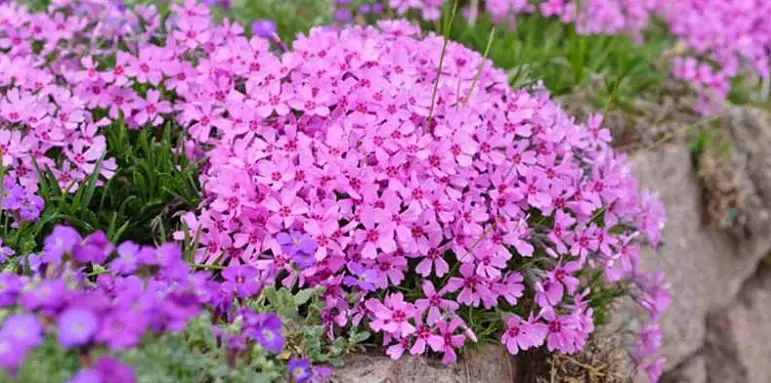Creeping phlox is a plant that loves to creep and spread, hence the name. It can be difficult to control but also provide a nice groundcover that will help prevent other weeds from popping up.
It does well when planted between other plants such as roses, hostas, daylilies, and many others. But when do you plant creeping phlox? Let’s find out…
When To Plant Creeping Phlox?
The best time to plant a creeping phlox is in the spring or fall. However, it’s important to plant a creeping phlox as soon as possible when you receive it.
Planting Creeping Phlox in Spring: If your plant is delivered in the spring, keep it moist in the container until your ground is ready for planting. Hold off on spring planting until the soil is free from melted snow and ice and the soil is warm and ready to work.
Planting Creeping Phlox in Fall: If you get your plant in the fall, hold it for a few days until it’s ready to transplant. You must, however, be cautious not to allow the roots to dry out. Plant a few weeks before your first frost arrives to ensure that they don’t die back.
If you live in an area where winters are harsh then be sure to mulch around your creeping phlox or even protect it with some pine branches during cold snaps (if they’re not too heavy) to ensure survival.
If you’re planting in the spring then that’s easy enough – just remember to water it well afterward! If you’ve planted creeping phlox later in summer or fall, this is where we get a bit tricky…
What Conditions Does Creeping Phlox Need for Planting?
Soil – The phlox is fine with most soils, but it does need to allow excess water to drain away so it’s not sitting in puddles. Soggy soil is dangerous as it can lead to root rot, which kills plants. You can improve soil drainage by adding some organic matter – maybe a bit of peat moss or shredded leaves.
Sun – Creeping phlox flowers best in full sun, but can tolerate partial shade. It does need at least six hours of sunlight per day to grow and bloom well, so don’t plant it too far into shaded areas or you’ll miss out on the blooms!
Spacing – Creeping phlox is a spreading plant that can be planted in clumps of three or more. It’s nice to have them next to each other, but you should leave about 2 feet between the plants. This will allow them to spread and flower better in your garden.
Caring for You Creeping Phlox Through the Seasons
Once the temperature reaches 50 degrees Fahrenheit or higher, garden phlox starts to emerge from its dormancy. The first sign of life is small green leaves that appear on short stems.
With proper care, your phlox plant will flourish and grow tall. Eventually, the stalk of each flower bud will start to shoot skyward from its base or root zone – it’s a good indication that you’re doing something right!
The sunshine seems to encourage the creeping phlox, as it blooms in a colorful display. The warmth of this season will make your yard more beautiful with these vibrant flowers.
Water your phlox regularly to help them flourish. Once they become established, don’t give them too much water as this can cause rot and damage stem in the garden – just enough so that all roots are wet but not drenched (1 inch of soil).
Phlox are drought-tolerant plants, which means you can enjoy them even with less rainfall than other types of flowers. They struggle in wet soil that causes both root rot and fungi infections if left unchecked.
What Else Should I Know?
You can fertilize your phlox flower in early spring, just before it blooms. The plant doesn’t need much help to grow and bloom beautifully each year!
Phlox are deer-resistant plants; however, rabbits can be a problem for them if there aren’t any other options available. Rabbits like to munch on the leaves of creeping phlox, so be sure to protect them with netting or fencing if necessary.
If you have pets that are known for digging holes in the garden then it’s best to place the plant on a low-lying ledge where they can’t reach it because their teeth will damage the roots!
Conclusion
In conclusion, when to plant creeping phlox is up to you and your climate.
Spring or fall planting will be fine as long as the conditions are right, but we recommend spring if possible because it’s easier for them to take root in moist soil than it is dry dirt.
Keep this information in mind when next you want to buy a creeping phlox plant and want to know when to plant it for the best results.
I hope this article was helpful and you have a better understanding of how to plant creeping phlox! If you need more information on when to plant it, what conditions they require, or anything else – please do reach out to me. I’m happy to help if I can.
Tim is an avid gardener from the UK. He was the founder of PlantCarer.com from 2021 to Sep 2023. He sold PlantCarer.com to Aaron. He has since started his own business called Seed To Supper, which provides new gardeners all the materials you need in a box (pots, seeds, compost and instructions) to grow your own delicious and nutritious vegetables and herbs from start to finish – no garden required.

